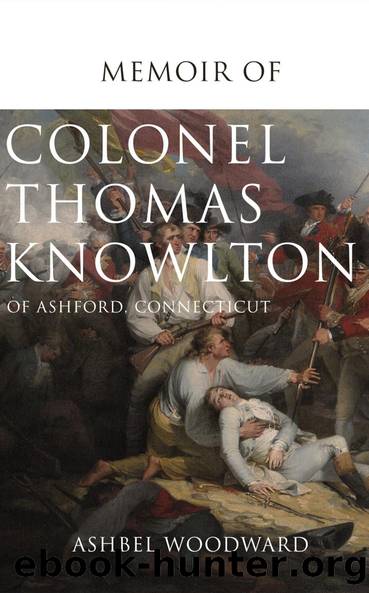Memoir of Col. Thomas Knowlton, of Ashford, Connecticut by Ashbel Woodward

Author:Ashbel Woodward [Woodward, Ashbel]
Language: eng
Format: epub
ISBN: 9781396320064
Barnesnoble:
Publisher: Left of Brain Onboarding Pty Ltd
Published: 2021-08-31T00:00:00+00:00
KEY TO THE BATTLE AT BUNKERâS HILL.
KEY TO THE BATTLE AT BUNKERâS HILL.
No. 1. General Israel Putnam was born in Salem, Massachusetts, 7th January, 1718; he was married at an early age, and removed to Pomfret, Connecticut. In 1755 he was appointed captain of a provincial regiment, and served for some time on the frontiers and in Canada, and rose to the rank of lieutenant-colonel. On the breaking out of the revolutionary war he repaired immediately to Boston, and was appointed a major-general. He was engaged in the battle of Bunkerâs Hill, and held an important command till December, 1779, when he had a paralytic attack, from the effects of which he suffered till the 29th of May, 1790, when he died at Brooklyn, Connecticut.
No. 2. Lieutenant Colonel Moses Parker, an American officer.
No.3. Samuel MâClintock, D. D., was born in Massachusetts, May 1, 1732; he graduated in 1751 at the college in New Jersey; Nov. 3, 1756, he settled as a minister in Greenland, New Hampshire, and died 27th April, 1804.
No. 4. Major Willard Moore.
No 5. Major Thomas Knowlton, of the Connecticut troops under Putnam; killed in 1776 in battle.
No. 6. Major Andrew MâClery; killed by a cannon shot after the retreat.
No. 7. Colonel William Prescott was born at Groton, Massachusetts, in 1726; he was a lieutenant in the provincial forces at the capture of Cape Breton in 1758, and greatly distinguished himself on that occasion. He had the chief command at the battle of Bunkerâs Hill, and was among the last to leave the entrenchments. He resigned his commission in 1777, but was present as a volunteer at the capture of Burgoyne by Gates, in that year. He died Oct. 13, 1795.
No. 8. General Joseph Warren was born in Roxbury, Massachusetts, June 11, 1741; he received a liberal education, and in a few years became an eminent physician in Boston. He was very active in organizing resistance to British oppression, and a prominent member of the secret committee raised for that purpose. A few days before the battle of Bunkerâs Hill he was appointed a major-general, but served as a volunteer and was killed in the battle.
No. 9. General Sir William Howe, who succeeded Gage in the command of the British forces in America, arrived at Boston in May, 1775. He commanded at the Battle of Bunkerâs Hill. In September, 1776, he captured New York. On the 27th September, 1777, he took possession of Philadelphia, and on the 4th of October defeated the Americans at Germantown. In May, 1778, he was succeeded by Clinton. He died in 1814.
No. 10. General Sir Henry Clinton. He succeeded General Howe as commander-in-chief of the British forces in America, and returned to England in 1782. In 1795 he was governor of Gibraltar, and died Dec. 23, 1795.
No. 11. Major John Small, a British officer, and a friend of General Putnam, who saved the Majorâs life in this battle.
No. 12. Colonel James Abercrombie, a British officer; he was killed in the battle.
No. 13. Major John Pitcairn was the British officer who shed the first blood at Lexington.
Download
This site does not store any files on its server. We only index and link to content provided by other sites. Please contact the content providers to delete copyright contents if any and email us, we'll remove relevant links or contents immediately.
Fanny Burney by Claire Harman(26529)
Empire of the Sikhs by Patwant Singh(22978)
Out of India by Michael Foss(16792)
Leonardo da Vinci by Walter Isaacson(13189)
Small Great Things by Jodi Picoult(7024)
The Six Wives Of Henry VIII (WOMEN IN HISTORY) by Fraser Antonia(5398)
The Wind in My Hair by Masih Alinejad(5034)
A Higher Loyalty: Truth, Lies, and Leadership by James Comey(4851)
The Lonely City by Olivia Laing(4751)
The Crown by Robert Lacey(4731)
Millionaire: The Philanderer, Gambler, and Duelist Who Invented Modern Finance by Janet Gleeson(4386)
The Iron Duke by The Iron Duke(4293)
Papillon (English) by Henri Charrière(4199)
Sticky Fingers by Joe Hagan(4105)
Joan of Arc by Mary Gordon(4017)
Alive: The Story of the Andes Survivors by Piers Paul Read(3970)
Stalin by Stephen Kotkin(3883)
Aleister Crowley: The Biography by Tobias Churton(3589)
Ants Among Elephants by Sujatha Gidla(3417)
